
| WWT Shows | CLICK TO: Join and Support Internet Horology Club 185™ | IHC185™ Forums |

|
• Check Out Our... • • TWO Book Offer! • |
Welcome Aboard IHC185™  Internet Horology Club 185
Internet Horology Club 185  IHC185™ Discussion Site Main Page
IHC185™ Discussion Site Main Page  Horological Discussions, Questions and Answers
Horological Discussions, Questions and Answers  Pocket Watch Discussions
Pocket Watch Discussions  MOORHOUSE AND WEBB C. BALL, HELLO!
MOORHOUSE AND WEBB C. BALL, HELLO!
 Internet Horology Club 185
Internet Horology Club 185  IHC185™ Discussion Site Main Page
IHC185™ Discussion Site Main Page  Horological Discussions, Questions and Answers
Horological Discussions, Questions and Answers  Pocket Watch Discussions
Pocket Watch Discussions  MOORHOUSE AND WEBB C. BALL, HELLO!
MOORHOUSE AND WEBB C. BALL, HELLO!Related Content: Ball Watch Company Research Forum
Go  | New Topic  | Find-Or-Search  | Notify  | Tools  | Reply to Post  |  |
| IHC President Life Member |
MOORHOUSE AND WEBB C. BALL, HELLO! Here's a really interesting E. Howard Series VIII that has surfaced in California. It is in the hands of our own Cheryl Ohland who is "lablover49" on eBay. Her interest at this point is in finding out everything she can about the watch, especially the dial. Although I am no expert on these dials, I believe I am seeing definite Moorhouse characteristics here. Going a bit further I can tell you this dial would have been originally sold on a watch retailed by Webb C. Ball Jewelers which was at that time located on Superior Road in Cleveland, Ohio making it essentially a "Private Label" dial. Do not confuse the retail jewelry store with the Ball Watch Company as that was a separate entity. But be that as it may, whenever a dial like this surfaces the combination of Moorhouse and Webb C. Ball, Cleveland, O. sets my pulse pounding. The case is engine-turned with a plain cartouche and marked "E. H. & Co." Case# 37223 and of course 14K as expected on high-end Howard Cases. Owner's inscription on the cuvette is Lyndon V. Grover - 1897 - Lynn, Mass. Is this a beauty or what? Series VIII Howard, Moorhouse for Webb C. Ball, Cleveland, O...  | ||
|
| IHC President Life Member |
Deer Marking "Adjusted" and "N" with Serial Number 305196... 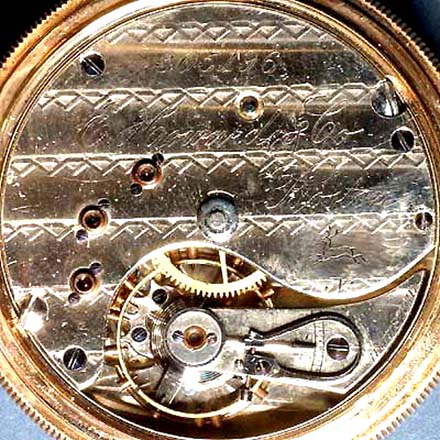 | |||
|
Lindell, I agree with you about this being a dial with the typical characteristics of Moorhouse dial. In the section of "Pocket Watch Discussions" locate the topic: MOORHOUSE DIALS .....School Is In Session. I'll bet Harold Visser will jump in here soon with his very expert knowledge. Indeed these are very desirable dials, especially if they are signed By J Moorhouse on the reverse. My dial is attached to an 18S Hampden. Here is the dial that I posted to that topic. Phil Dellinger 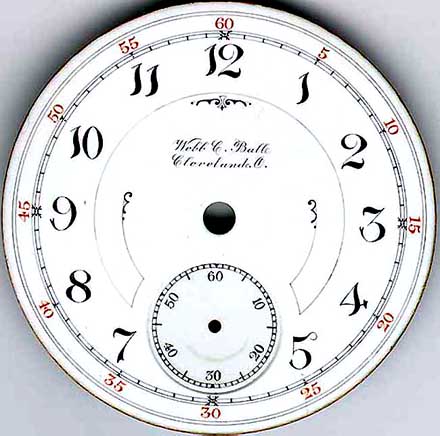 | ||||
|
| IHC Member 179 E. Howard Expert |
YES, that is a Josiah Moorhouse dial!! Harold Chapter 112,174,185 | |||
|
| E. Howard Expert |
I have seen three Ball Howard Moorhouse dials in my travels. A signed example with unique calligraphy, that I used to own, is pictured in my August 1993 BULLETIN article. Another I saw in the collection of the late Mr. Don King, although I don't know if it was signed on the reverse. I have also heard an unconfirmed report of yet another example. In my August 1993 article, I also showed a Ball Hampden dial essentially identical to the one shown on this thread. I speculated then that Moorhouse may for a time have freelanced for Hampden after his departure from Howard some time after 1894, but I tend not to believe that any longer. I now think that the Ball Hampden dials in the Moorhouse style were conscious, "unauthorized" copies of Moorhouse. (Moorhouse's style wasn't copywritten, so there was no way really to prevent this.) Furthermore, Howard Moorhouse dials have a certain delicateness of feature that seems to be absent in the Hampden copies. Clint Geller | |||
|
| IHC Member 179 E. Howard Expert |
Hello everyone, thought maybe a closer look at the dial would be appreciated, and yes it is signed J. Moorhouse on backside! Comparing the "Webb C. Ball Cleveland, O." logo to Phil's Hampden Moorhouse dial logo,it seems to be almost completely identical in style and form. Harold 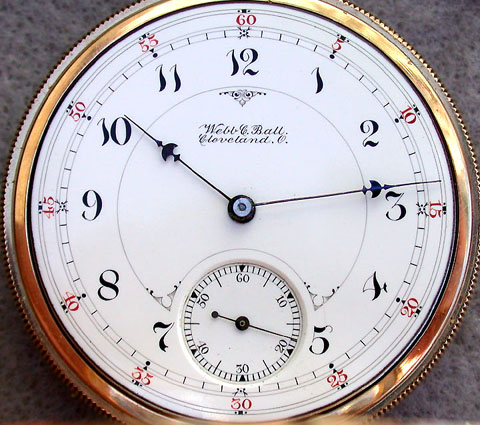 | |||
|
| E. Howard Expert |
That's another great Moorhouse you reeled in there, amigo. Clint Geller | |||
|
| IHC President Life Member |
YOU'RE RIGHT DR. GELLER... WHAT TASTY EYE-CANDY!!! Harold, I'll tell you, since that gorgeous example could not come home to Northern Ohio it's nice to know it's comfortable in Arizona! Two questions... First, did you by any chance photograph the back of the dial? I'm sure the only chance many of us will ever have to see the real-deal signature-wise would be if you'll to share it with us. Secondly, has anyone ever put examples such as the possibly-Moorhouse Hampden and the known to be authentic Howard in front of a handwriting expert? That could prove very interesting! Lindell | |||
|
| IHC Member 179 E. Howard Expert |
Here's the backside of the dial, the signature is baked into the enamel. Harold 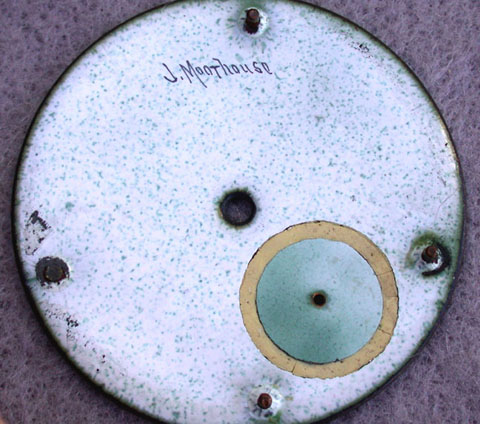 | |||
|
| IHC President Life Member |
WOW!!! My earlier question about a handwriting expert comparing the artwork on the dial. Would there be any point to that? Dr. Geller's opinion about the Hampden version lacking the delicacy-of-touch really intrigued me. That and the fact they were not signed, though I understand some thought to be genuine were not. Thanks for sharing not only your watches but your expertise! For those who'd like to see the "real-deal" even closer...  | |||
|
I'm resurrecting this old thread to say that upon closer inspection of the E. Howard dials versus the Ball-Hampden, the numbers and flourishes do look a bit different, meaningful or not. Also the signage, or lack thereof between those timepieces, is interesting. kh | ||||
|
| IHC Member 665 |
Nice to see this good old topic alive, again. Here is an unsigned 18s Ball-Hampden dial for comparison. JBS 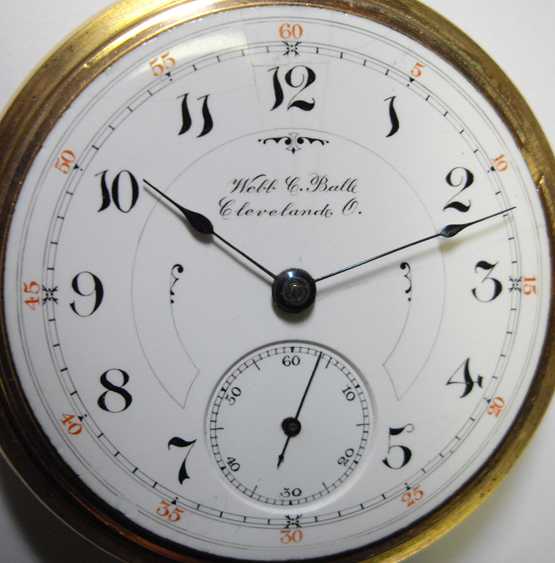 | |||
|
John Great dial, do we have the serial number or a pic of the movement? This should be in the Ball forum. There is a related Moorhouse topic there. Moorhouse topic happy hunting | ||||
|
| Administrative Assistant |
We have linked them (moving could destroy some of the old links) so both will be accessed from the Ball Watch Company Research Forum for everyone to see. | |||
|
| IHC Member 665 |
I found the dial loose. I have applied it to 23J Special Railway 1150060, a beautiful tu-tone movement but not a Ball-Hampden movement, of course. I do not own a Ball-Hampden movement. My basis for this disposition is that the dial is the same as that shown by George Townsend in Plate 170 of his book American Railroad Watches. It is noted, there, that the dial in Plate 170 is from the personal watch No. 1201174 of J C Dueber. When I enquired of Col Townsend as to the kind of movement that it was, he wrote back and advised me that it was a 23j Special Railway. I have his letter, dated 19 September 1981. | |||
|
John Thanks John, Given that Ball and Dueber had a somewhat contentious relationship, it always amazed me that Dueber would carry a watch with a Ball dial. Col Townsend was a well respected authority and his word will have to suffice. Thanks again for the pic. happy hunting | ||||
|
beautiful combination | ||||
|
I'm new to this group and thrilled to see so much great information. I hope this photo upload goes well... I recently picked up an Elgin grade 162. The movement does not have any markings other than the original Elgin engraving. The production year was 1900 and from what I can tell, the case does not have any other mounting screw marks. And here is the dial. It is unsigned. From reading many posts, it's apparent that it has some of the Moorhouse attributes. In the absence of that signature, is it possible to determine if it is a Moorhouse or if it is likely original to the movement? 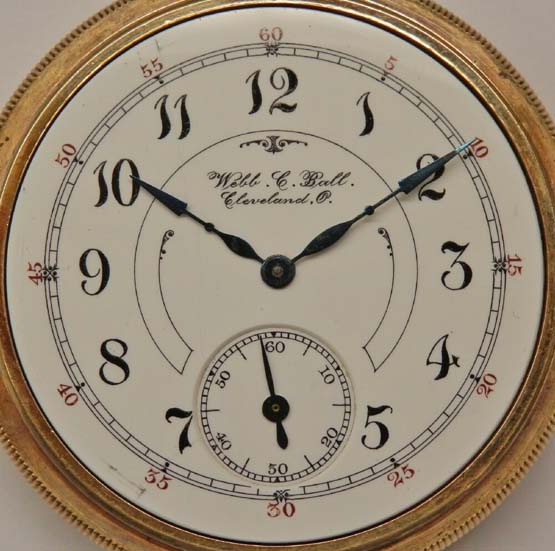 | ||||
|
Mike- Your dial is well done, and has the required characteristics of a JM dial, but I'm troubled by the difference in brand signage between yours and Harold Visser's - especially the period and spacing after the first name "Webb" which today we would think has no reason to be there. That's not to say it can't be JM's work, but in combination with the dial's lack of signature, I would not make a strong claim either way. We know now from discovered court records (discovered after this thread started) that Josiah Moorhouse did in fact work for Hampden for a short time after his second stint in Waltham for the Waltham Watch Company. In a recent phone conversation Lindell suggested it is quite possible that he also had one or more assistants at Hampden and that the "Webb C. Ball, Cleveland" dials were most likely painted while he was employed by Hampden in nearby Canton, Ohio. It is also suspected but not proven, that a few Elgin dials are authentic Moorhouse. But fancy Arabic-numbers on any particular dial do not necessarily indicate his work. Other artists painted some fine-looking watch chapters - especially toward the end of the 19th century, when Arabic-numeral dials were first becoming RR preferred. The O'Hara Dial Company comes to mind. Lindell has an 1872 Model Waltham with a Daniel O'Hara Masonic Dial considered to be authentic. See the 2004 topic "MASONIC DIAL, SILVER CASE, 1872 WALTHAM" for more details about that one. At this point a small minority of collectors believe that only the signed as Moorhouse dials are actually are his work. Interestingly, there are some very elaborate surviving unsigned dials and some very mundane, but signed dials held by different collectors. What should one make of that? Only that we don't know all the facts, and perhaps we never will. We don't actually know that he signed all of the dials he painted, and we don't know how many he himself painted. After a lot of reading and conversations with a number of long-time collectors, I have a slightly more liberal interpretation - that some of the unsigned dials may also have been the work of Josiah Moorhouse or painted under his direction. Still, unsigned dials present difficulties, especially to collectors unfamiliar with JM characteristics. If there is an authentic signature on the back of the dial (baked in), one might feel convinced that the dial authorship is his. Otherwise, it might be best not to make the claim. I'll also say that I've purchased two watches with apparent JM dials, betting that they were signed, and was right both times. Of course the higher value is in the signed ones. Anyway, there is still a lot to learn about the Moorhouse lifetime and career. I'm still hoping to see a signed Moorhouse dial that may have been painted in the 1860s. We're also a diary or some lost letters away from knowing important pieces of his story, and answering some lingering questions. But our subject is worth the time spent. He was a highly skilled individual, and in demand throughout his career, from Appleton Tracy & Co. to Nashua to Waltham to Hampden to E. Howard, and then back again at Waltham and from as early as 1858 to as late as 1902 he did some beautiful work. K. | ||||
|
Hi Mike and welcome to the message board!!! I recently worked on Mike's Elgin 162 and the Webb C. Ball dial in hand is very beautiful, but as Mike said unmarked. As you can see Mike there is a lot of good information you can gather here and best of luck finding out more information on your dial. Rob www.pocketwatchrepairs.net | ||||
|
Thanks guys. I'm going to call it Moorhouse-ish. I too noticed the brand signage was off and that's enough for me. Appreciate the feedback. And Rob, thanks for the nice repair work. Moorhouse or not, it's a beautiful dial on one of Elgin's finest movements from the turn of the century. Glad to have it in my little collection. | ||||
|
Ken My Ball Hampden 410538 has what I call a Moorhouse style dial. It is unsigned and we know that Ball advertised these watches beginning in April of 1890, nearly two years after Moorhouse was employed at Hampden. Sure Ball could have obtained the dials from Moorhouse, but then you would expect a signature. Seems more likely to me it was a style copy, which considering that the same thing happened to Montgomery, shouldn't surprise us. happy hunting | ||||
|
Agreed, Bill, except in the comparison. Montgomery dials are a lot less idiosyncratic than Moorhouse dials. For that reason, and because Montgomerys were repeatable (by template), I think they were a much more likely rip-off. They certainly are a lot more common. You also have to wonder why Jos, with such a unique style, wouldn't want to chase down unauthorized copies. I don't know law, but I could imagine that he might have had a pretty good case if had just taken the trouble anywhere along the line to copyright his work -- which it seems he did not. Another interesting question that no one asks is What did a Moorhouse dial look like before he got to E. Howard in 1886? Jos started his career at Appleton Tracy & Co. in 1858 when he was just 17. Having likely already served an apprenticeship in England, he was by 1859 skilled enough to be recruited by Belding Dart et al to work at the now famous start-up called Nashua. That's many years before the time period from which we identify his mature work. Could anyone identify his work from 1880? 1870? Earlier even? At what point did he start adding the quarter-hour mulberry characters? And when did he begin signing dials? Handwriting analysis through the decades by an expert might not be a bad idea. K | ||||
|
Correction: Josiah Moorhouse was 17 when he arrived in New York from England on August 22, 1854. He began his employ at Appleton, Tracy & Company, the immediate predecessor of the American Watch Company, on August 3, 1858, at the age of 21. And I can add a note that is buried in 19th century literature: At the Nashua Watch Company, which is the predecessor of the Nashua Watch Dept. at Waltham (The American Watch Co.), he was put in charge of dial making (not just dial painting). So, he was skilled in a specialized and needed way already. Aaron Dennison and others earlier made special ocean-going (of course) trips to England to find someone skilled in that craft because they hadn't found anyone in America who was! | ||||
|
| Powered by Social Strata |
| Your request is being processed... |
|
Welcome Aboard IHC185™  Internet Horology Club 185
Internet Horology Club 185  IHC185™ Discussion Site Main Page
IHC185™ Discussion Site Main Page  Horological Discussions, Questions and Answers
Horological Discussions, Questions and Answers  Pocket Watch Discussions
Pocket Watch Discussions  MOORHOUSE AND WEBB C. BALL, HELLO!
MOORHOUSE AND WEBB C. BALL, HELLO!
 Internet Horology Club 185
Internet Horology Club 185  IHC185™ Discussion Site Main Page
IHC185™ Discussion Site Main Page  Horological Discussions, Questions and Answers
Horological Discussions, Questions and Answers  Pocket Watch Discussions
Pocket Watch Discussions  MOORHOUSE AND WEBB C. BALL, HELLO!
MOORHOUSE AND WEBB C. BALL, HELLO!©2002-2025 Internet Horology Club 185™ - Lindell V. Riddle President - All Rights Reserved Worldwide

